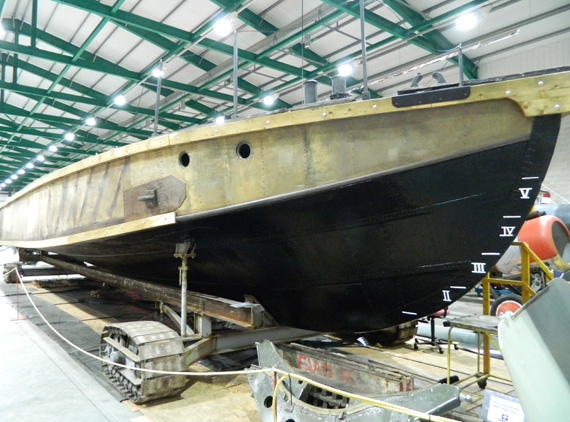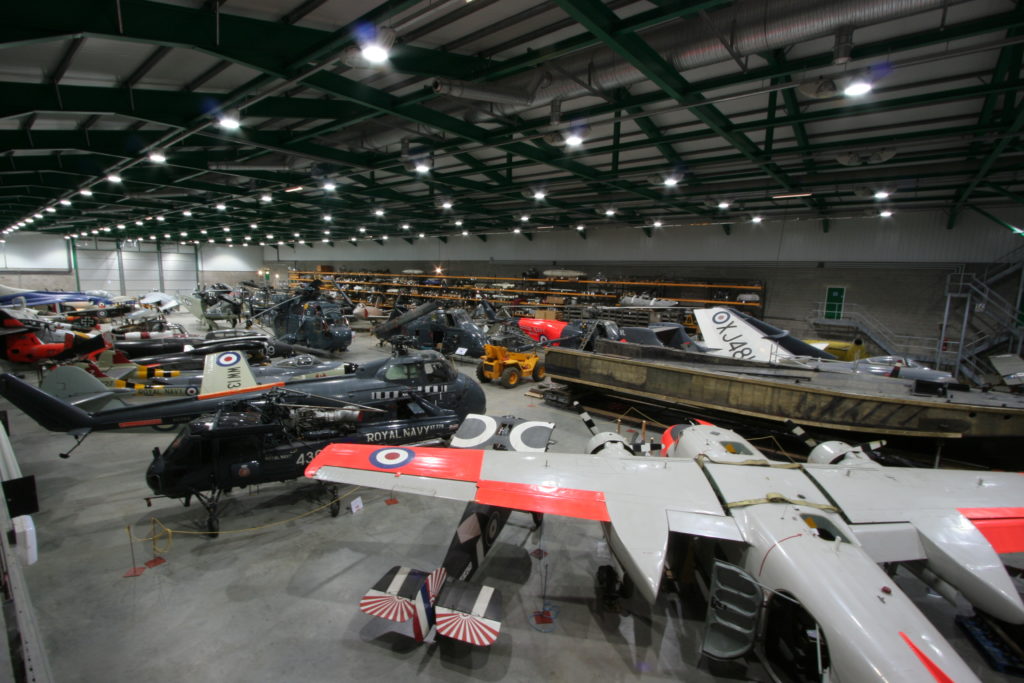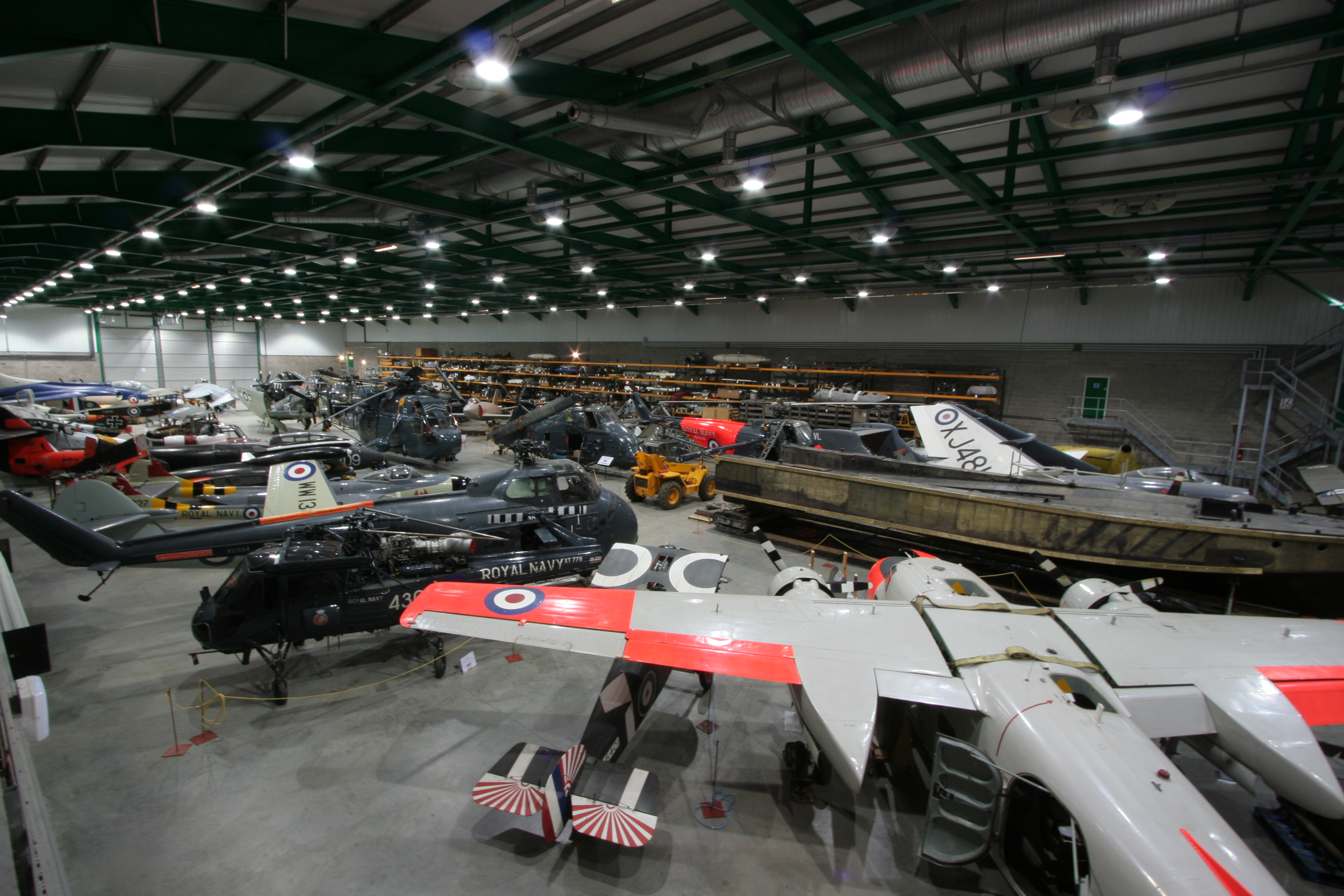The Fleet Air Arm Museum is home to hundreds of historic aircraft and thousands of other artefacts and records, making it the largest naval aviation museum in Europe. However, some of the museum’s most precious treasures are held locked away in its reserve collection, Cobham Hall, which is ordinarily off-limits to the general public. The hall houses 30 rare and unique aircraft, as well as vessels such as the Seaplane Lighter H21, which is the oldest aircraft carrier in the world and a huge milestone in maritime history. Also on display in the hall is a Supermarine 510, a number of Westland helicopters and a Sea Harrier XZ499, which flew sorties during the Falklands War.
Over four dates in 2018, Cobham Hall is opening its doors to members of the public, providing the opportunity to tour its exhibits, as well as see a number of records and other items. The hall is only open for a limited number of slots, and tours will be conducted by the museum’s senior curator, David Morris. Below, History of War has two tickets to give away for entry on 7 June 2018, including free entry to the main museum.
Read on as, David Morris explains more about Cobham Hall’s unique collection, and some of the highlights of what visitors can expect to find.

What was the idea behind opening up the reserve collection to the public at Cobham Hall?
That stems from a couple of reasons really. The actual storage facility was a Heritage Lottery funded project. The Fleet Air Arm Museum wouldn’t have been able to fund an enormous new conservation and preservation store without some kind of grant support and the Heritage Lottery Fund supported that.
As part of their agreement the building should be made accessible to the public for the first ten years under their recommendations and timings. They accepted that we needed to make a small charge to cover the running and starting costs for that and there was a reason to have it open three times per year if possible. So for the first time in years we were beholden to that as part of the Heritage Lottery Fund agreement.
It proved successful and people were so keen to come and look at the air reserve collection. People that were interested in machines also came for the building, because the building was impressive enough in itself in some ways. They saw items that have been in the collection but in reserve that hadn’t yet made it onto the display or had been cycled around.
People were interested in that and quite a lot of specific aircraft enthusiasts were keen to come and see the collection, which had previously been stored 60 miles away at Wroughton on the RAF site. There was a lot of purpose interest and a lot of reasons for people to want to come, which surprised us actually and we were pleasantly surprised. So we continued that where possible, depending on load and staffing availability. We kept that going so beyond that first ten year period. We try and make slot times available three times through the year and to just keep providing that option of interest.
How many aircraft will be on display?
The entire Fleet Air Arm Museum collection now holds 103 airframes. We had 103 aircraft in total in the collection with approximately 50 percent are on display and 50 percent in store. At any given time you are going to see somewhere around 50 airplanes displayed in the main exhibition halls within the museum. Therefore, we would have approximately 50 in the Cobham Hall reserve store facility, but there is a lot to see. The reserve collection store is as big and as interesting and fascinating in some ways in their own right just by the nature and the size of our collection.
What is the age range and variety of the aircraft?
We’ve got all the covers and sizes in. It’s a very, very extensive collection. We’ve got extensive components from Airship SR1, which was one of the Royal Naval Air Service semi-rigid airship planes. We’ve got our very accurate replica Sopwith Pup, built by Skysport Engineering and incredibly close to the original Sopwith’s detailing and specification. We have aircraft from them that go right the way up to the Sea King and Harrier, which has recently come out of service and pretty much everything in between. We span 100 years of aircraft.
We’ve also got Westlands, because they are only seven miles down the road. Westland Helicopters have long made aircraft for the Royal Navy so we’ve got a very close linked collection partly with the navy and partly with our hometown of Yeovil. You are likely to see fighter reconnaissance aircraft and anything that the Fleet Air Arm and the Royal Naval Air Service were using in what we call part of our core collection so we have a full range.
Many people are interested in Second World War history. Are there lots of aircraft from that period at the open day?
The Second World War aircraft tend to be already on display, we try to keep a high complement of Second World War aircraft on display in the main exhibition hall. We’ve got two currently in storage, both Firefly Aircraft Mark IV and Mark I. We’ve got a Fairey Albacore in store at the moment and we’ve got a Wyvern and a post-World War II Westland Wyvern. It’s unique because it’s the world’s last surviving Wyvern and that’s currently in store making exhibition space for our recent conflict aircraft in Hall 4.
We cycle the aircraft around. This is part of the intrigue, interest and the beauty of the Cobham Hall. It is working for us as a working store: we respond to anniversaries and exhibition date changes quite quickly now and can swap aircraft between the main side and the Cobham Hall store relatively easily with the gate and track bay system that we’ve got in place. This enables aircraft to be towed from one site to the other. So we always ask people to be very mindful of checking our website because if you’ve come to see a very specific aircraft, you might want to check what’s on and off display.

What can visitors expect from the open days guided tours?
Surprise I think. Hopefully delight, but usually surprise. Surprise at the size of the building, surprise at the nature of the building and the mechanical aspects of it. We also explain how the building functions, how the doors work, how the environmental system works and how the specification of the building was put together.
We had consultants and used architects and building designers who worked with us. We described what we needed as a high-spec museum storage building, not just a big tin shed and they actually worked very hard to produce the building that we need and use today. So I think people find the building quite fascinating in itself.
Then of course once you are able to walk around with someone like myself who understands the collection in depth that makes a great difference having that live interpretation. I’ve realised that people are always saying, “It’s so much more fascinating being able to walk and talk with somebody to discuss what’s in there rather than just read text boards.”
We do a day on different months of the year. We’ve got 8 March, which is a Cobham Hall open day, 7 June, 6 September and then again on 6 December. We have four days allocated this year to have Cobham Hall tour days. Those are ticket days now. It’s easier to do this now running as a ticket per session. There’s three sessions per day and they’re one-hour sessions. You go online and you can choose which one you want-10:30, 12:30 or 2:30 tours and you get in for one hour with a small group. You are in a group of around fifteen people per tour.
As the Curator of Aircraft, I take a group individually around the aeronautical collection, which is in store and describe and explain some of the background histories of some of the aircraft: why we have them, why they’re important and of course answer questions if people have got them. So it’s a question and answer walk round session with myself as the Curator of Aircraft and that’s what we’re buying into as a bespoke tour.
Do you have a favourite aircraft in the collection and if so for what reason?
I don’t think that there is any aircraft in the collection that I wouldn’t find fascinating or interesting in some way, shape or form. They all have their own individual looks, feel, history and associated background so I couldn’t really choose a favourite.
How important is the Fleet Air Arm for military aviation history?
That’s a really good question. A lot of people see our museum and our collection at a glance and often think, “What is the Fleet Air Arm?” and then when they ask the question they start to think a little deeper. The Fleet Air Arm is the flying arm of the Royal Navy and has actually been in place longer than the RAF. People don’t realise that until they look a little further into it. The Royal Naval Air Service started in 1914 while the RAF was developed out of the Royal Flying Corps before combining with the Royal Naval Air Service in 1918. Naval pilots were being trained on fixed wing aircraft as early as 1911-12 and the navy was flying kite balloons and airships from 1909. So actually, the navy’s flying associated history in Great Britain predates most things and that’s something that we are keen to try and promote because that can get lost in the generalisation of news and media.
Just quick referencing to military aircraft flying, people very innocently and readily think of the RAF and they don’t necessarily realise that there’s a whole flying wing to the Royal Navy, which dates back over 100 years. The significance of that of course is that the navy is mobile, has ships and floats all around the globe. So whereas the Royal Flying Corps, what’s now the Army Air Corps and the RAF are very much more land based and can operate from forward flying zones the Royal Navy has backup on aircraft carriers and they take their airfield wherever they want to go. They basically float their airfield anywhere around the globe and operate from it, just like they would here at RNAS Yeovilton. They basically take a smaller version of Yeovilton, put it into the ship and take that with them so that the Royal Navy’s flying capabilities is always ready to be global.
I think that’s the big message difference, which is that the Royal Navy can turn up anywhere and operate effectively, as has been shown in Arctic and jungle regions, the Western Front, Falklands, Bosnia and Afghanistan. The navy are there as much as anybody else and operating from their close supporting ships. So wherever there is hostile activity or humanitarian aid the navy are able to achieve being there. I think that’s a message that we constantly try and promote because it isn’t all hostile and fighting either, there’s a lot of humanitarian aid and hurricane relief and support that go on around the world where a carrier can be there quite swiftly and be able to support.

To discover more about the Fleet Air Arm Museum, please visit: www.fleetairarm.com
For your chance to win two tickets to Cobham Hall and entry to the Museum, simply answer the question below
